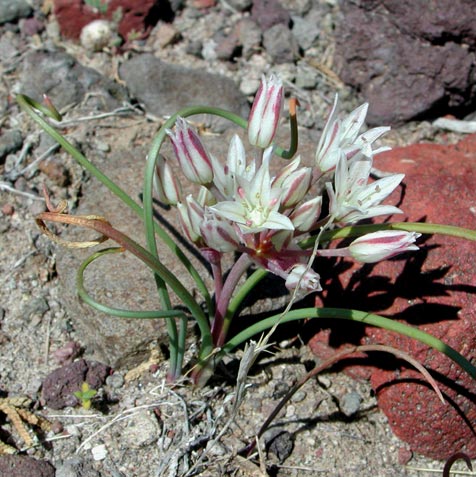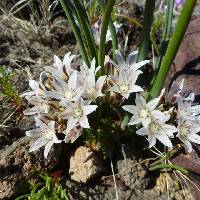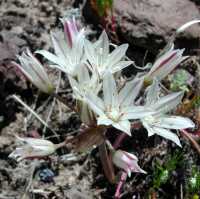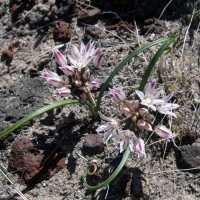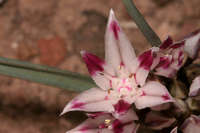
|
|
|
|
Family: Amaryllidaceae
Bigelow's Onion, more...Bigelow onion
|
Bulbs usually solitary, not clustered on stout primary rhizome, ± globose, 1-1.5 × 1.2-1.5 cm; outer coats enclosing single bulb, dark brown, prominently reticulate, membranous, cells irregularly arranged, vertically elongate, rectangular to ± contorted, without fibers; inner coats white, cells obscure, quadrate. Leaves persistent, green at anthesis, 2, basally sheathing, sheaths not extending much above soil surface; blade solid, subterete to channeled, 16-21 cm × 2-4 mm, margins entire. Scape persistent, solitary, erect, solid, terete, 5-12 cm × 1-4 mm. Umbel persistent, erect, loose to ± compact, 10-25-flowered, hemispheric, bulbils unknown; spathe bracts persistent, 2, 2-11-veined, lance-ovate to ovate, ± equal, apex acute to acuminate. Flowers campanulate, (8-)10-14 mm; tepals erect, pink to reddish at tip and along midvein, otherwise white, lanceolate, ± equal, becoming papery and ± rigid in fruit, margins entire, apex acute; stamens included; anthers purple; pollen yellow; ovary crested; processes 6, prominent, flat, triangular, margins entire to coarsely toothed; style linear, equaling stamens; stigma capitate, scarcely thickened, obscurely 3-lobed; pedicel 10-15 mm. Seed coat shining; cells smooth. 2n = 14. Flowering late Mar--May. Open, rocky, gravelly slopes; 500--1700 m; Ariz., N.Mex. Allium bigelovii is an anomalous species that does not appear to be closely related to any other from North America. With its prominent ovarian crests, a relationship with the group of species around A. fimbriatum, A. nevadense, and A. sanbornii is suggested. Allium bigelovii differs from this group, however, in having two leaves and a seed coat with smooth cells. In addition its bulb-coat reticulation is unlike that of any other North American species.
FNA 2003, Martin and Hutchins 1980 Duration: Perennial Nativity: Native Lifeform: Forb/Herb General: Strongly scented scapose perennial from a usually solitary bulb that is generally globose and 1-1.5 cm in width with dark brown outer scales. Leaves: Basally sheathing with persistent leaves that are green at anthesis, usually 2, the blade solid to subterete or channeled, each 16-21 cm long by 2-4 mm in width, the margins entire. Flowers: Terminal and erect umbel on a scape 5-12 cm long by 1-4 mm wide, the umbel can be loose or compact with 10-25 flowers that have pink perianth parts, the tepals erect with acute apex and entire margins, pink to reddish at tip and along midvein, otherwise white; flowers April-May. Fruits: Capsule that is crested containing little shining seeds. Ecology: Open, rocky, or gravelly sites; 2,000-5,500 ft (610-1676 m). Distribution: Ranges across Arizona and New Mexico. Notes: The flowers look similar to A. macropetalum, but note the intense pink/red tips of the tepals. Ethnobotany: Unknown Etymology: Allium is Latin for garlic, while bigelovii is named for Dr. John Milton Bigelow (1804-1878) who collected under Whipple on the Pacific Railroad Survey of 1853-1854. Synonyms: None Editor: SBuckley, 2011 |
This project was made possible in part by the Institute of Museum and Library Services [MG-70-19-0057-19].
Powered by Symbiota

